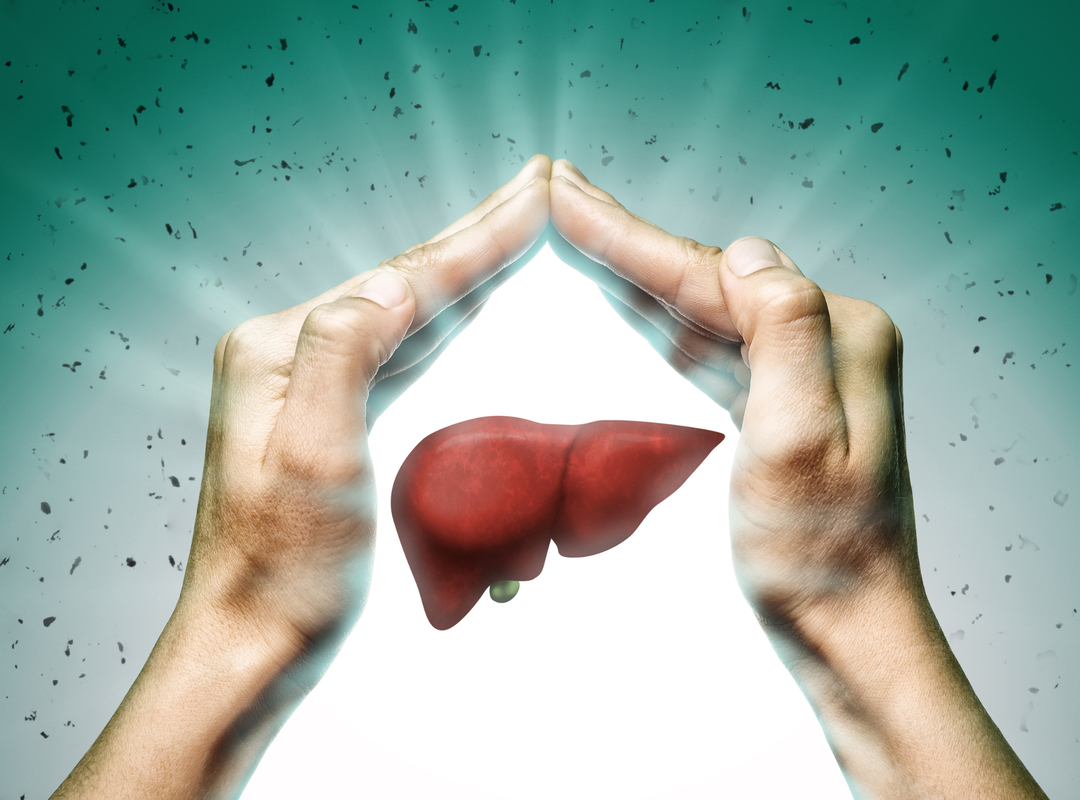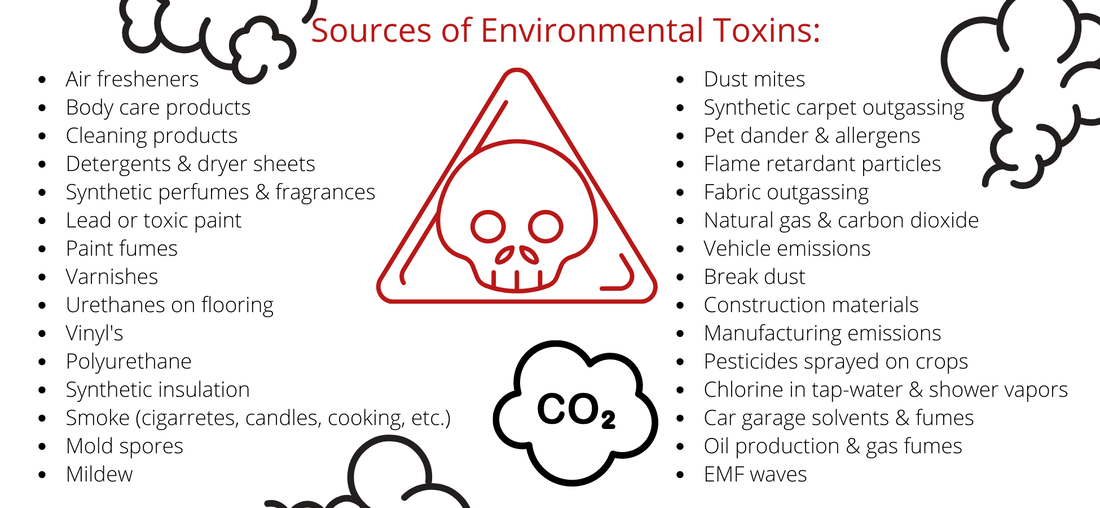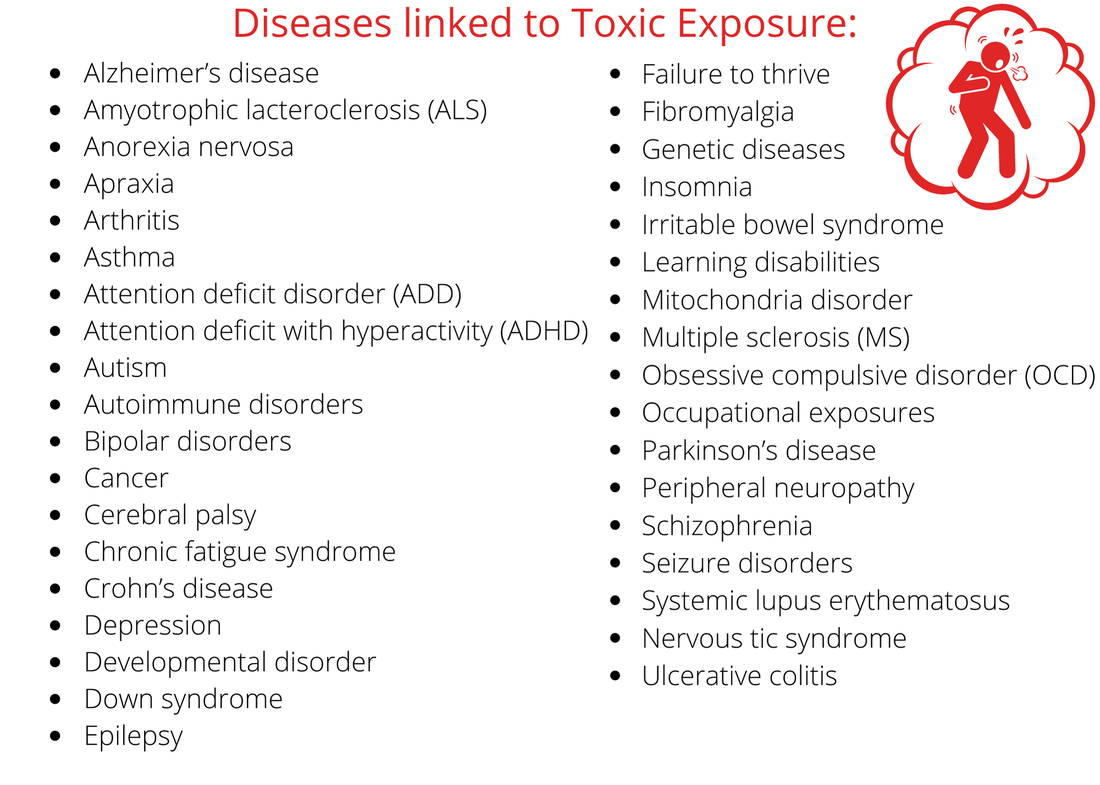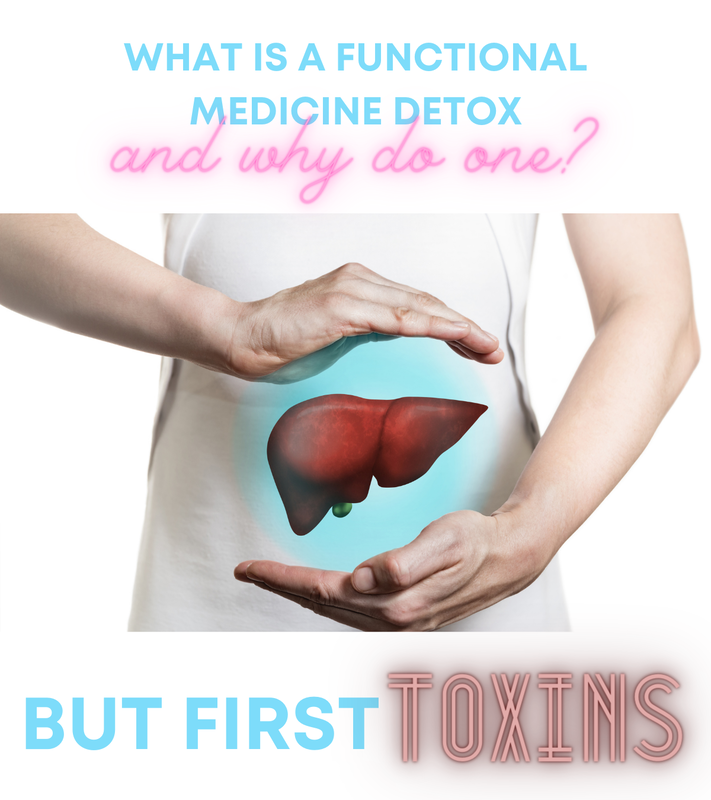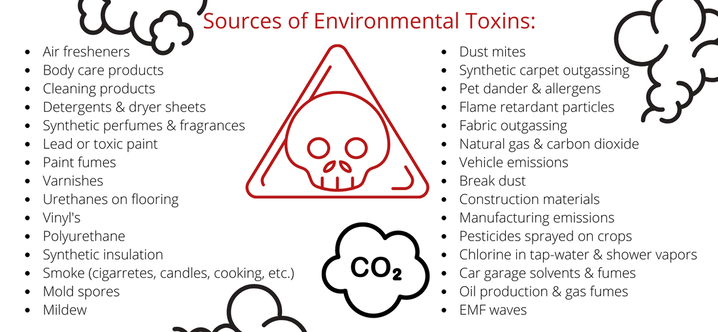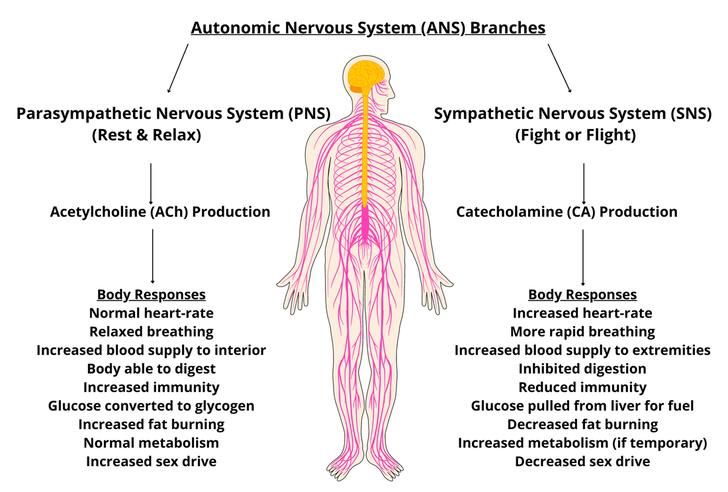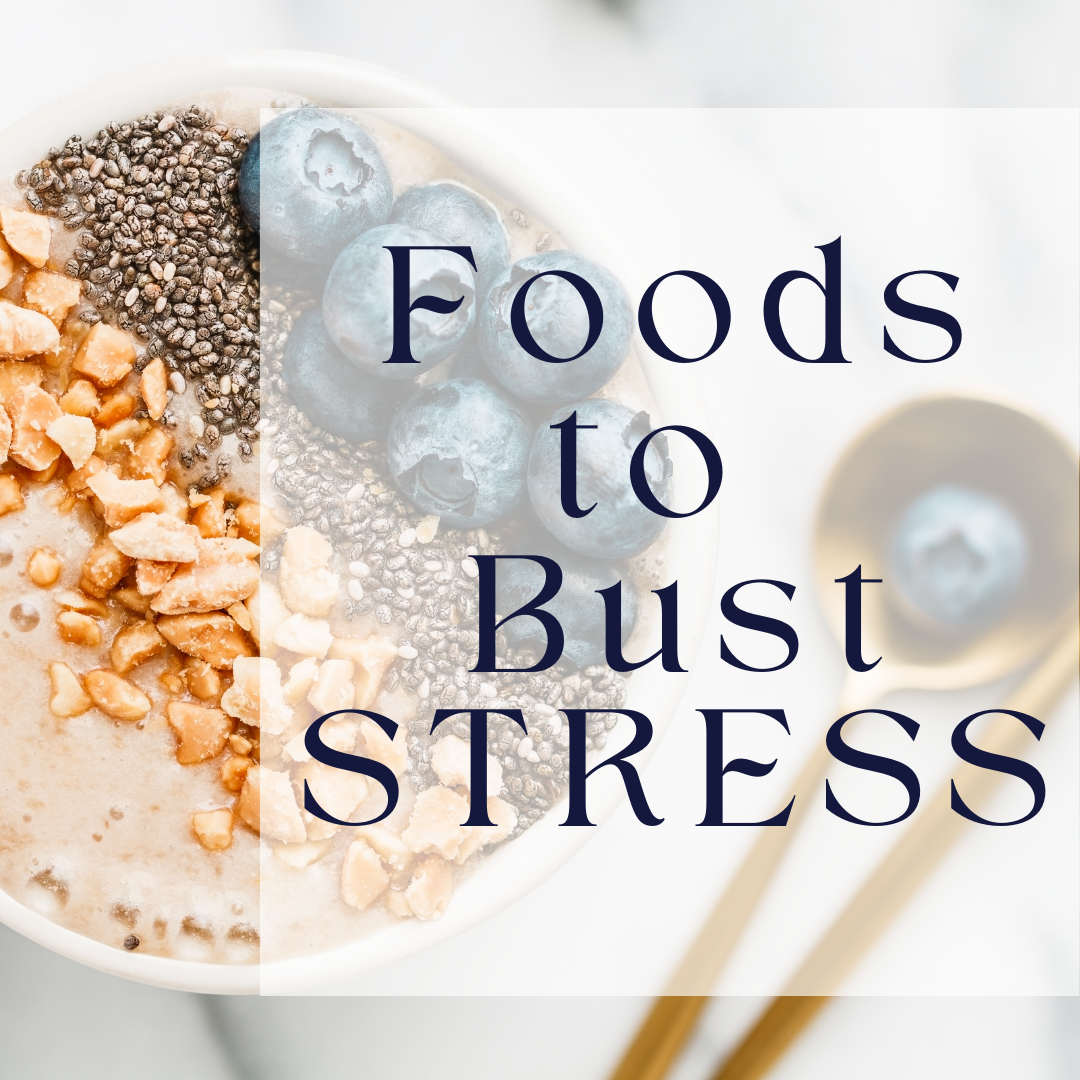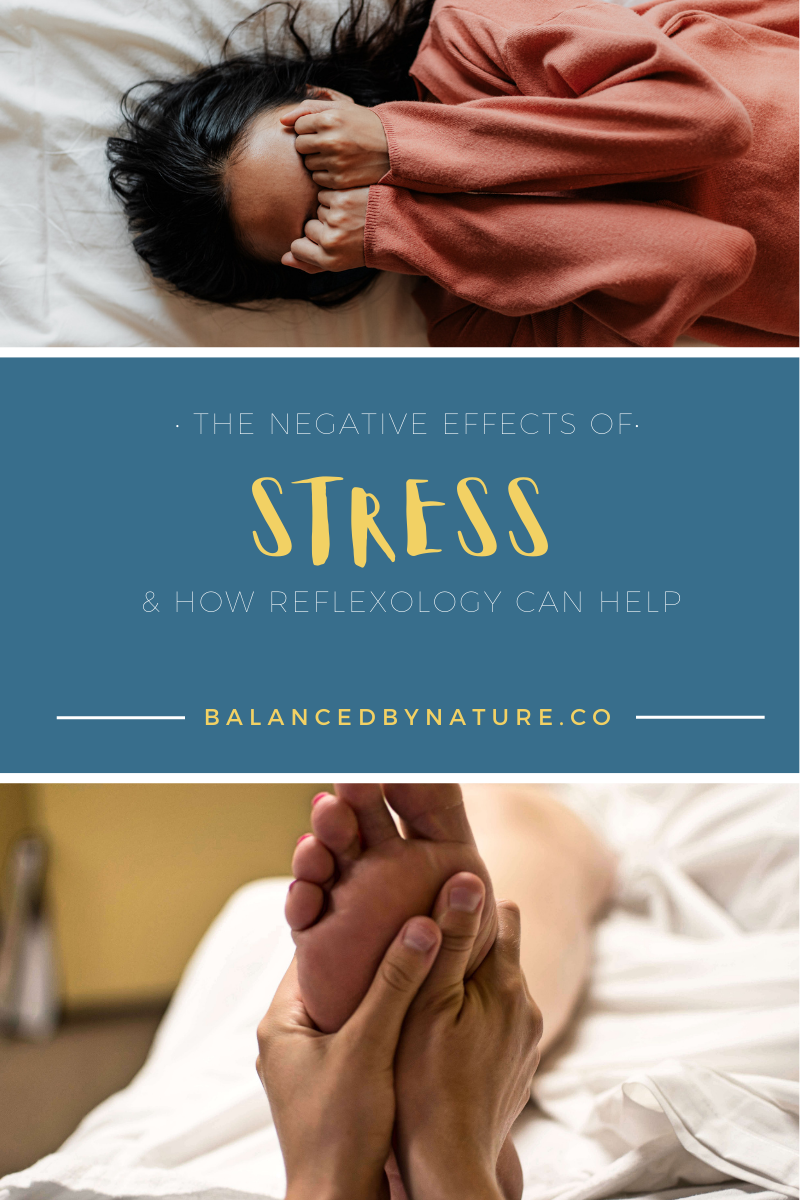|
"Why should I detox?" When discussing detoxification with people, I often hear variations of the following arguments against it. Either they have heard they should only do a “cleanse” in the Spring, or they believe it is just another “new” health fad and that their bodies can detoxify naturally without assistance. Let me address these step by step: “I have heard I should only do a ‘cleanse’ in the Spring” First off, I just want to clarify that a detox is NOT a cleanse as these processes serve very different purposes. The confusion comes from the fact that these terms are often (yet mistakenly) used interchangeably because they can have similar-feeling health outcomes of feeling refreshed, vibrant, and even lighter from the inside out; also, they both serve important health purposes. However, there are some distinct differences between a Cleanse and a Detox:
“Detoxification is a fad” First, detoxification isn’t a new concept or fad at all. In fact, it has been practiced for thousands of years by ancient Ayurvedic Practitioners followed closely in time by Chinese Medicine Practitioners. Even at times when environmental pollution wasn’t at the scale we know today, these practitioners recognized that toxic overload occurs and begins to block eliminatory pathways which leads to toxic build-up in the body. This creates an environment ripe for illness and/or disease to present themselves. Additionally, if we look to nature, we can see that we are provided with herbs, nutrients, and minerals that promote detoxification and eradicate toxicities from our body systems. Therefore, it would seem that there is a time and a place which these naturally occurring substances are called for and even necessary to maintain health and well-being. "I already eat healthy and live a healthy lifestyle, therefore I don't need to detox" I agree, eating healthy is definitely a vital part of maintaining good health. But unfortunately - and despite our best efforts - we are still exposed to environmental pollutants simply by living on this planet. In fact, according to the online publication Phys.org (2017), every year humans emit 250 billion metric tonnes of chemical substances....and this number is growing. Please see the chart below showing just a few of these toxic sources as well as the next section for further information about pollutant exposure. "The body is capable of detoxifying itself and doesn't need help" Yes, the body is an amazing network of systems that has an incredible ability to rebuild, regenerate, and to a degree detoxify itself. However, I would point out again that detoxification was necessary for optimal health for thousands of years, prior to the industrialization of society and the unprecedented levels of toxicity that we see today. A scientific study called 10 Americans which was conducted by the Environmental Working Group (EWG) and presented by the EWG President Ken Cook, showed that the average American is walking around with around 287 detectable toxins in their bodies. The most alarming part of this discovery is that 212 of these toxins found have been banned for at least 30 years which led to the conclusion that these individuals were exposed in utero, with toxins being passed to the fetus from their mother through the umbilical cord. In fact, in another study, 232 toxic chemicals have been found in the umbilical cord blood of U.S. newborns (Goodman, 2009). Many of these having been shown to be carcinogenic, cause birth defects, are hormone dysruptive, as well as cause cognitive issues. Considering that these individuals were exposed to these chemicals prior to birth shows that the body is not capable of processing out the massive amount of man-made toxins that it was exposed to then, or the new ones that it has (and will) continue to be exposed to. There is also the fact that there have been no long-term studies of many chemicals (or their combinations) in our bodies as well as our unborn children on a staggering number of these toxins. The scale of toxic exposure is growing! The scientific magazine Phys.org quoted Julian Cribb from his book Surviving the 21st Century (2017): "The European Chemicals agency estimates there are more than 144,000 man-made chemicals in existence. The US Department of Health estimates 2000 new chemicals are being released every year. The UN Environment Program warns most of these have never been screened for human health safety." "The World Health Organisation estimates that 12 million people – one in 4 – die every year from diseases caused by 'air water and soil pollution, chemical exposures, climate change and ultraviolet radiation', all of which result from human activity." Here are a few more startling facts about environmental toxicity (info acquired from The Rain Barrel Effect by Dr. Stephen Cabral; 2017)):
Put succinctly, a child that is born today, and all of us that are currently living, are exposed to more than 144,000 man-made chemicals that did not exist only 150 years ago. Given that these chemicals did not exist such a short time ago, it is evident that our bodies were not “built” to deal with this massive onslaught. This is further evidenced by the prevalence of developmental disorders and conditions such as ADD & ADHD in our society. The result of these toxic exposures are numerous health conditions such as ADD & ADHD, cancer, digestive dysfunction, inflammatory issues, and neurological disorders. In fact, there are numerous health conditions some of which are listed below: Our bodies need our help! Perhaps in years past, when environmental toxicity was minimal, doing a detox only a few times in a lifetime may have been enough to maintain relatively good health. But given the 144,000+ man-made toxins that we have to contend with in today's world, it is necessary to regularly relieve the body of its toxic burden in order to keep pace with all of these toxic exposures on a daily basis. This is especially true given that cancer, inflammatory diseases and cognitive dysfunction have become so prevalent in our world. What is your total Toxic Load? Are you curious what your toxic load is? Take the "Toxicity Assessment." Want to read more about toxins, their effects on the body, and how a Functional Medicine Detox can help? Visit my previous blog post What is a Functional Medicine Detox and why do one? Ready to lighten your Toxic Load? If you are ready to take your health into your hands, join my upcoming FREE Community Detox Group on Facebook! The next Group Detox begins January 9th! This detox is going to be extra special because hundreds of IHP's from worldwide (like myself) are joining forces to lead a record-breaking number of people through the detox together! Act now because the deadline for purchasing your detox kit in time for being part of this world-wide movement is December 31st! Click below for more Detox Group Info! References:
10 Americans. (2012). YouTube.com. Retrieved December 25, 2022, from https://youtu.be/0-kc3AIM_LU. Cabral, S. (2017). The rain barrel effect: How a 6,000 year old answer holds the secret to finally getting well, losing Weight & Feeling alive again! Amazon. Retrieved August 9, 2022, from https://www.amazon.com/Rain-Barrel-Effect-Finally-Getting/dp/1975774833 Goodman, S. (2009, December 2). Tests find more than 200 chemicals in newborn umbilical cord blood. Scientific American. Retrieved December 26, 2022, from https://www.scientificamerican.com/article/newborn-babies-chemicals-exposure-bpa/ Scientists categorize Earth as a 'toxic planet'. Phys.org. (2017, February 7). Retrieved December 25, 2022, from https://phys.org/news/2017-02-scientists-categorize-earth-toxic-planet.html
0 Comments
Every day we are exposed to numerous toxins from products that we use in our homes and on our bodies and tap-water we drink to environmental toxins floating around in the air as well as pesticides being sprayed on our crops (even if we are not eating foods that are sprayed, this can still be drifting in the air!). In fact, according to a 2009 Center for Disease Control report, “-Americans of all ages are carrying around over 219 toxic chemicals in their body at any given time...” (Cabral, 2017). A few additional {and disturbing} facts about toxins (info acquired from the book The Rain Barrel Effect by Dr. Stephen Cabral):
This is problematic because our bodies are not equipped to deal with this toxic load as the introduction of toxins has only begun since the Industrial Revolution. According to Dr. Stephen Cabral “...every newborn baby that comes into this world is already filled with man-made toxins that weren’t even a part of our world just 150 years ago.” “But what happens to these chemicals once they have entered the body?” This is where the liver comes in as it works to filter all the blood in the body every 6 minutes to remove toxins from the bloodstream. The liver does this through phase I & II pathways which result in the conversion of toxins into by-products that are either stored in the body or excreted through the normal excretory pathways (urinary/bowel/sweat/etc.). The issue is that the liver is not equipped to deal with the massive amount of man-made toxins that we are exposed to every day, and it is not able to keep up with the demand of processing all these toxins. This results in a “toxic overload” which is then stored in the body, generally in adipose tissue (fat cells). Having toxic overload leads to a host of health issues including poor immunity and digestion, as well as hormonal imbalances and an excess of inflammation in the body. These, in themselves, lead to further health complications which manifest as the dis-eases which are considered the main killers in the United States: heart disease, high blood pressure, diabetes, and cancer. In fact, medical studies are showing that by the year 2030, 1 in 2 people in the United States will develop cancer in their lifetimes. Put another way, half the population of the U.S. is expected to develop cancer in their lifetimes. Previous statistics put this number closer to 1 in 3, however the numbers are rising which begs the question of what could be the cause of this increase? The only apparent variable that can account for this massive increase in expected instances of cancer is the fact that there are so many new chemicals (and so many more being introduced every year) that we are constantly being exposed to. In fact, there is such a large amount of chemicals that the majority have not been tested for safety or what is considered safe levels of exposure. Further, there is no data for long-term exposure since many of these chemicals haven’t existed long enough for this information to be collected.  Other symptoms of “Toxic Overload”
“Okay, so what can one do about the Toxic Load in their body?” With all the above information about the ample toxins that we are exposed to and the health issues that toxic overload can cause, things might seem bleak for our health and the health of our children. However, there are things that we can do to limit our exposure such as purchasing “cleaner” products for our home and body care, drinking pure spring or filtered water, and buying organic or wild harvested/caught foods where possible. However, the most important thing you can do for your health is a Functional Medicine (FM) Detox which uses specific vitamins and nutrients that are necessary for promoting the clearing of phase I & II detoxification pathways of the liver. This in turn allows the body to begin releasing excess toxins which the liver can then convert into water-soluble byproducts that are excreted through normal pathways. What is your total Toxic Load? Take the "Toxicity Assessment." Find that you need to "lighten your toxic load?" Please join my upcoming Free Detox Group on Facebook. Find more info below! Are you ready to get your digestive health back, lose weight, balance your hormones, calm excess inflammation, or just experience vibrant health? Click HERE to learn more about my upcoming Functional Medicine Detox Group on Facebook! When you join the group, you will receive Free IHP Health Coaching guidance for 30 days including direct messaging access to me to answer any questions you might have regarding the detox along the way. I will also go live on Saturdays at 3pm GMT to answer questions and discuss any challenges and triumphs as well as to encourage each other along the way. The only requirement is to purchase the 7-, 14-, or 21-day Dr. Cabral Detox (a Functional Medicine Liver Detox) using THIS LINK and you will be admitted into the group upon request. Reference:
Cabral, S. (2017). The rain barrel effect: How a 6,000 year old answer holds the secret to finally getting well, losing Weight & Feeling alive again! Amazon. Retrieved August 9, 2022, from https://www.amazon.com/Rain-Barrel-Effect-Finally-Getting/dp/1975774833 As overstimulating (and “hangover-inducing”) as the “Vagus Nerve” might sound, it is extremely important for the function of some vital organ functions and is a key component in activating the Parasympathetic Nervous System (PNS; the state of rest and relaxation and/or digestion of the body). Stimulating this nerve helps to interrupt the body's stress responses, which can be the cause of numerous health issues that I will outline below. But first, the Nerve(s) The vagus nerve is one of 12 cranial nerves that runs from the brain stem directly to the organs that it affects (bypassing the spine) that are referred to as the effector organs. In the case of the vagus nerve, these effector organs are the heart, lungs, liver, gallbladder, stomach, and intestines (Archer et al., 2013). When the brain receives stimulus suggesting that the body is under stress (whether these be hormonal feedback loops or outward as well as inward influences), this information is relayed from the brain to the effector organs via the vagus nerve. The result is increased heart rate and respiration, and decreased function of the digestive organs which is a response of the Sympathetic Nervous System (SNS; the state of fight/flight). This response redirects energy that would normally go toward digestion and assimilation to responses of perceived threats. You might be familiar with the sensations of having “butterflies” in your stomach or a racing heart when you are nervous. You can thank the direct link between your brain and your heart and digestive organs via the vagus nerve (and the response of the SNS) for this. However, through the employment of some techniques that are outlined below, the vagus nerve can be stimulated to send communication back to the brain which then in turn tells the Central Nervous System (CNS) to calm down. (Please see a previous blog post in the “Geek Section” for more information on the CNS). Signals from the CNS can then disrupt hormonal feedback loops which can perpetuate the stress response. Warning: This post runs a little long, so if you'd just like to scroll ahead to the end to see the ways of stimulating the Vagus Nerve, I totally get it! Otherwise the sciencey stuff.... A Quick Lesson about the Parasympathetic Nervous System (PNS) & the {say it with me} Hypothalamic-Pituitary-Adrenal (HPA) Axis Before getting too far into the vagus nerve, I do need to discuss the Parasympathetic Nervous System (PNS). It is one of two branches of the Autonomic Nervous System (ANS), along with the Sympathetic Nervous System (SNS) (Cabral, 2017) which is our “Fight or Flight” response. The ANS oversees subconscious activities such as our heartbeat and breathing (Newman, 2022) and is a crucial factor in moving food through the digestive tract as well as how our nervous system responds to stimuli that we experience. The HPA axis refers to a chain reaction of hormones that originate at the hypothalamus and travels to the pituitary and then adrenal glands. Stimuli from the brain sends a signal to our hypothalamus which, through this hormonal pathway, prompts the release of either acetylcholine (ACh) or catecholamines (precursors to cortisol: norepinephrine or epinephrine; CA’s) which directs what the body puts its energy toward, either survival mode or rejuvenation mode. When our bodies are in a PNS (rest and relax state), ACh is released which then leads to further hormone responses for normal body functions such as healthy digestion and reproduction. This is the state that our bodies are intended to be in most of the time. When our bodies are in a SNS (fight or flight state), CA’s are released which leads to a {hopefully} temporary stress response and then to a reduction in vital organ functions so that energy can be supplied to the extremities (arms for fighting, legs for running, as well as increased breathing, heart rate, and glucose production to power it all). Both systems have their place and are necessary factors in maintaining the human body. Responses of the PNS & SNS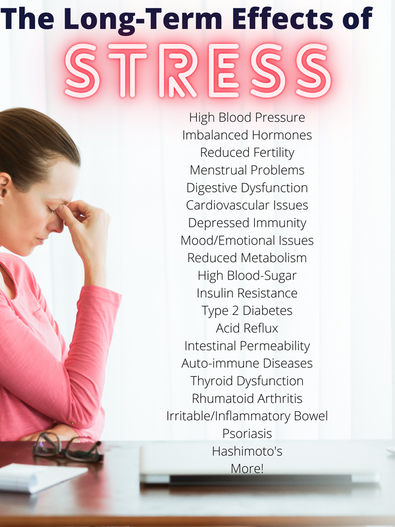 (Archer et al., 2013; Cabral, 2017) Long-term effects of Stress However, today, we tend to get stuck in a prolonged stress response due to daily stressors such as finances, time-crunches, and environmental stressors which wreak havoc on our health in several ways. These include hormonal, reproductive, digestive, cardiovascular, immunity, emotional, and mental health issues. Additionally, our metabolism is thrown out of whack because of sustained high blood glucose levels which leads to several body dysfunctions such as insulin resistance as well as type 2 diabetes (Diabetes UK, n.d.). Fat burning also stops since the bodies preferred fuel source is glucose and when we are under stress, glucose is in high supply. A couple of crucial factors to highlight here are the effects of stress on the digestive and immune systems since so many of us struggle in these two areas (which affects other body functions as well). When our bodies are consistently in a state of high stress, our digestion suffers in many ways. These include weakened production of stomach acids and digestive enzymes, as well as reduced bowel peristalsis (motility). This can lead to digestive problems, intestinal permeability, inflammation, and immune-based issues such as autoimmune disease(s), thyroid dysfunction, and long-term “dis-eases” (states of being in dis-ease) like rheumatoid arthritis, inflammatory and/or irritable bowel disease, psoriasis, Hashimoto's, and more. As you can see, I could go on and on and it would take many more posts to discuss all the effects of stress on the body. In short though, our entire body system suffers and is thrown out of whack. If you are interested in reading more about the effects of stress and how to mitigate it, please hop over to my previous posts: Reflexology & Stress Eat Your Stress Goodbye And now, without further ado...... Vagus to the Rescue! Stimulating the vagus nerve is beneficial for physical and mental health, as its effects are decreased overall heart rate, lowered blood pressure, and improved digestion as well as improved stress recovery. This is due to what is referred to as “vagal tone” which is a health indicator measured by variability of the heart rate between inhaling and exhaling. When there is higher variability between these two numbers, this is considered good vagal tone and is an indicator of general good health (Heller, n.d.). Stimulating the vagus nerve helps to increase vagal tone and improves how the body is currently responding to stress as well as how it will respond to stressors in the future. Methods of Stimulating the Vagus Nerve: Pranayama (Breathing Exercises): The Belly Breath is one of the quickest ways of calming the nervous system via the vagus nerve. It is done by drawing long, slow, and deep breaths through the nose and into the belly, holding momentarily, and then softly blowing the breath out through the mouth. This can be done as few as 3 times or until your desired state of calm is achieved. What is so great about this is that we can consciously access the effector organs (namely the lungs and digestive organs) which communicate directly with the vagus nerve by using this breath. Other forms of Pranayama such as Nadi Shodhana (alternate nostril breathing), Visamarvrtti (square or same breath), the Complete Yogic Breath (drawing the air into the belly, then filling up the lungs and releasing in reverse order) are also great ways and can be searched on the internet. Chanting or Humming: Another way to stimulate the vagus nerve is to do a breathing meditation using the ‘aum’ technique in which you take relaxed long and deep breaths and then as you exhale you recite the vowels AAAAAAAA-UUUUUUUU-MMMMMMMM (pronounced AH-OO-MM, in one pro-longed exhalation). If you are uncomfortable with the ‘aum’ technique, you can inhale deeply and keeping the lips closed make a ‘mmm’ sound as you exhale through your nose, producing the same effect. Either of these can be performed from 30 seconds to 1 or more minutes and is a wonderful way to enter a calmer and more meditative state. Meditation/Mindfulness/Prayer: Each of these are great ways of being in the moment which are excellent ways of getting into the PNS mode. In this world where we are always in “go” mode or either dwelling on the past or thinking about the future, we are often disconnected from the present moment which is very taxing to our Central Nervous System (CNS). The way to counter this is to intentionally be in the present moment. This can be done by sitting comfortably and quietly and either focusing on your breath (or the sensation of the breath entering and exiting the nostrils), focusing on sounds around you, or being in a state of receptivity. Another option is to walk in nature and notice sights, sounds, colors, or anything else that you can bring your awareness to. This could be the sound of your footsteps as you walk or of the wind blowing through the trees. The idea is to expand your awareness and step away from the small daily grind of your life. Unplug: Unplugging from our devices is so important since most of us have the habit of constantly checking our phones for new notifications and either work with technology or get our entertainment through it. In fact, most people spend extraordinarily little time away from screens; therefore, it is important to set aside time every day to do just that. Also, it is scientifically proven that the blue light from screens affects our melatonin levels which in turn affects our ability to get a good night’s sleep. Not getting proper rest along with the body regeneration that takes place during that time is yet another stressor on our body and can keep us in the SNS mode. Exercise/Movement: We all know that exercise is important for our health on so many levels including that it improves our outlook through the boost of endorphins that it results in. In addition to this, exercise improves both our respiratory and cardiovascular health which in turn improves vagal tone (Cleveland Clinic, 2022.). Further, regular moderate exercise helps us to handle stressful situations better and to be in the PNS mode more often. I will note here a caveat that excessive exercise can be taxing to the CNS which can put us into SNS mode. For those who are experiencing symptoms of being overly stressed, overly vigorous exercise should be avoided until these stress-levels can be brought into normal ranges. In these cases, moderate exercise is best such as walking in nature and focusing on calming exercises like movement therapy, yoga, and/or tai chi. One set of daily exercises that will not over-tax the CNS is the “Energization Exercises,” created by Paramhansa Yogananda (author of the book Autobiography of a Yogi). Doing this daily is beneficial as it helps to awaken the body and mind, oxygenates the lungs, and brings focus to specific body parts and the breath (good for mindfulness). It also strengthens the body while calming the CNS and stimulates the vagus nerve both directly and indirectly via specific movements and breath techniques. It is great for getting the lymphatic system moving and thus supports your immune system as well. As a bonus, it is a great practice to do in preparation for meditation and/or mindfulness techniques as it helps to prepare the body for meditation and calms the mind. Reflexology: Reflexology helps to interrupt the stress feedback loop that keeps the body in a sympathetic state by calming the CNS. It is also excellent for increasing vagal tone, relieving anxiety, and promoting homeostasis throughout the body. To read more about how Reflexology can help mitigate stress please click here to read my previous blog post on the subject. In Conclusion I truly do believe that being naturally "equipped" with something like the vagus nerve is miraculous as, when it is accessed, it can so profoundly change both our physical and mental health. Please let me know what your experience is on this subject and if you try any of the methods above, how it went for you! References Ananda Sangha Worlwide. (2021). Yogananda's Energization Exercises.YouTube. Retrieved June 3, 2022, from https://youtu.be/TpiKXmLNJ-0. Archer, P., L. A. Nelson (2013). The Nervous System, Applied Anatomy & Physiology for Manual Therapists (1st ed., pp. 196–199). Chapter 7, Lippincott Williams & Wilkins. Cabral, S. (2017). The rain barrel effect: How a 6,000 year old answer holds the secret to finally getting well, losing Weight & Feeling alive again! Cabral Research LLC. Cabral, S. (2019). The Role of Intestinal Permeability & Stress on Your Immunity. DESTRESS Protocol - Stress Section. Online Training, Cabral Research LLC. Retrieved May 20, 2022. Cleveland Clinic. (2022, March 10). 5 ways to stimulate your vagus nerve. Retrieved June 2, 2022,from https://health.clevelandclinic.org/vagus-nerve-stimulation/#:~:text=Interval%20training%20and%20endurance%20training,respiratory%20function%2C%E2%80%9D%20says%20Dr. Diabetes UK. (n.d.). Stress and diabetes. Diabetes UK. Retrieved May 30, 2022, from https://www.diabetes.org.uk/guide-to-diabetes/emotions/stress#:~:text=Stress%20alone%20doesn't%20cause,amount%20of%20insulin%20they%20make. Green, H. (2015, April 20). Parasympathetic nervous system: Crash course anatomy & physiology #15. YouTube. Retrieved May 29, 2022, from https://youtu.be/qqU-VjqjczE Heller, D. P. (n.d.). Calming a Wigged Out Autonomic Nervous System Using the Vagus Nerve [web log]. Retrieved June 2, 2022, from https://www.innisintegrativetherapy.com/blog/2017/11/21/calming-a-wigged-out-autonomic-nervous-system-using-the-vagus-nerve#:~:text=The%20higher%20the%20tone%2C%20the,and%20a%20reduction%20in%20migraines. Newman, T. (2022, February 3). Central nervous system: Structure, function, and diseases. Medical News Today. Retrieved May 23, 2022, from https://www.medicalnewstoday.com/articles/307076#what-is-the-cns When you’re stressed out, the foods that you’re turning to are most likely going to be traditional ‘comfort’ foods – think big meals, take-out, fatty foods, sweet foods, and alcohol. Let’s face it – we’ve all found some comfort in a tasty meal and a bottle of beer or glass of wine when we’ve been stressed out or upset about something. However, this isn’t a good permanent solution.
When you’re turning to unhealthy foods you can feel better temporarily, but in the long run, you will feel worse. When your body isn’t getting the right nutrition, you can begin to feel less energetic, more lethargic, and in some cases less able to concentrate and focus. All of this can lead to even more stress. Foods that Fight Stress If you’ve been feeling more stressed out than usual lately, it’s important to know which foods are best to choose and which to avoid when it comes to combating stress and helping you to deal with feelings of stress and anxiety. The best way to fight stress is to have a healthy, balanced diet that is high in nutrients. Filling up on foods such as whole grains, leafy vegetables, fruits, healthy fats, and lean proteins as the basic staples of the diet is the best way to ensure that your body gets the optimum amounts of nutrients to fight both physical and mental health problems. When it comes to choosing the foods to eat, some have a range of great properties which help the body to combat stress. Choosing these stress-busting foods will help to heal and calm your mind permanently, rather than providing a temporary fix. Some of the best stress-fighting foods include: Blueberries – If you’re feeling stressed out and reaching for the snacks, swapping chocolate or chips for one of the best superfoods is a great way to help you deal with your stress levels and achieve a higher level of calm. Blueberries have some of the highest levels of antioxidants, especially antho-cyanin, which means that this berry has been linked to a wide range of health benefits including sharper cognition, better focus, and a clearer mind – all of which can help you to better deal with stress. Chamomile Tea – Of course, it’s not all about what you’re eating when it comes to managing stress; what you’re drinking can also alleviate or worsen the stress you're feeling. Drinking liquids which are high in sugars and caffeine, such as coffee, energy drinks or soda, can actually increase your stress levels if consumed regularly. Chamomile tea has long been used as a natural bedtime soother, and it has also been used in clinical trials, which determined that chamomile tea is effective in reducing the symptoms of generalized anxiety disorder. Avocado – Avocados are a creamy and versatile fruit which can be eaten in a range of different ways whether you enjoy it raw, made into sauces, dressings and dips, or in a smoothie. These nutrient-dense fruits have the properties to stress-proof your body, thanks to their high glutathione content which specifically blocks the intestinal absorption of certain fats which cause oxidative damage. Avocados also contain higher levels of vitamin E, folate, and beta-carotene than any other fruit, which boosts their stress-busting properties. Grass-fed beef – Though I don't recommend eating beef more than 1-2 times per week, grass-fed beef is not only kinder to the planet and to animals, it’s also good for people, too. Grass-fed beef has a huge range of antioxidants, including beta-carotene and Vitamins C and E, which can help your body to fight stress and anxiety. If you’re looking for more reasons to spend a little more money on organic, grass-fed beef, it’s also lower in fat than grain-fed beef while being higher in omega-3. Oatmeal – Oatmeal is great in that it can be a filling comfort food, but also has a large number of healthy properties to actually make you feel better from the inside out. A complex carbohydrate, eating oatmeal causes your brain to produce higher levels of the feel-good chemical serotonin, helping you to feel calmer and less stressed. Studies have shown that kids who choose oatmeal for breakfast tend to be much sharper throughout the morning in school compared to kids who had alternative morning meals. Chocolate – Although it’s usually seen as an unhealthy treat, there is an undeniable link between chocolate and our mood. Studies have shown that eating chocolate can actually make you happier. However, that doesn’t mean that you can start munching on chocolate bars every time you're stressed out – chocolate works best as a de-stressor when eaten in moderation and as part of a healthy and balanced diet. Dark chocolate in particular is best for you, as it contains more flavonols and polyphenols, two hugely important antioxidants which can help combat stress, more than many fruit juices. Walnuts – If you’re looking for a healthy snacking option which will help you to stay better in control of your stress levels, walnuts are a great choice. There is no denying the sweet, pleasant flavor of walnuts and they can be a tasty snack for in-between meals or as part of a desert. A versatile nut, walnuts are great for salads, or add them to a sweet treat such as coffee and walnut cake. Green Leafy Vegetables – leafy, green vegetables should be a pivotal part of anyone’s diet. Along with helping to combat stress, leafy greens are full of nutrients and antioxidants which help to fight off disease and leave your body feeling healthier and more energized. Dark leafy greens, for example spinach, are especially good for you since they are rich in folate, which helps your body to produce more mood-regulating neurotransmitters such as serotonin, which is a ‘feel-good’ chemical. Making leafy greens a part of your diet will help you to feel happier and less stressed out overall. Fermented foods – last but not least, eating fermented foods such as yogurt can help to keep your gut healthy, which actually in turn will help to improve your mental health and reduce stress levels. The beneficial bacteria which are found in fermented foods such as yogurt actually have a direct effect on your brain chemistry and transmit positive mood and behavior regulating signals to your brain via the vagus nerve. Putting Together Your Diet Plan Planning your meals wisely is key to not only staying physically fit and healthy, but also staying mentally strong and being able to best manage your levels of stress. Knowing which foods to avoid and which are the best to reach for to snack on when you’re feeling worried and anxious is important to helping you get control over your emotions and fears. When you’re feeling stressed, you may be tempted to reach for classic ‘comfort foods’ – usually foods which are laden with sugar, very starchy, or greasy. However, although these foods can make you feel momentarily better, they will actually make you feel worse in the long run. Having stress-busting snacks such as fresh berries, dark chocolate, yogurt, walnuts or pistachios, or even a fruit smoothie with avocado and leafy greens in it can help you to feel better in both the short and long term when it comes to stress. When it comes to combating and dealing with stress in the long run, it’s important to make sure that for the most part, you are eating a diet which is healthy and balanced. In order to stay on track, it’s a good idea to make a meal plan for your week and plan ahead to make sure that you have a good selection of these stress-busting foods in your kitchen to make meals and snacks from when you’re feeling like stress-eating. Making sure that the majority of your meals include foods such as lean proteins and leafy green vegetables will not only make you feel healthier overall, but can improve your mental health and stress levels, too. A good example of a healthy, stress-busting menu would be: Breakfast: Oatmeal with berries or a fruit smoothie with avocado and berries Mid-morning snack: Natural yogurt with fruit or a handful of pistachio nuts Lunch: A whole-grain pasta salad filled with plenty of leafy greens Afternoon snack: Dark chocolate Dinner: Grass-fed beef with vegetables Before bed: Chamomile tea Of course, you don’t need to stick to this menu – but it gives you a good idea! Remember to exercise good portion control when eating foods such as nuts, chocolate, yogurt or avocado! As the saying goes, you are what you eat – so make sure that first and foremost, you’re filling yourself up with foods which are good for your mental health. If you missed my previous blog post about how stress affects your health and how Reflexology can help to mitigate or interrupt the stress response please CLICK HERE to read. CAM Modalities for Stress The popularity of holistic health modalities - also known as Complementary and Alternative Medicine (CAM) - continues to rise as more people are seeking alternatives to the symptoms-based approach of standard Western medicine. The holistic or CAM approach to health focuses on finding the root causes of disease and illness; with a particular focus on mitigation of stress since it is believed that stress is responsible for causing 90% of disease and illness (NASD, n.d.). Our stress levels are an important factor in every facet of our health as stress can lead to hormonal imbalances which affect our endocrine system (literally our hormonal control center), cardiovascular, reproductive and digestive issues (being in a state of “Fight or Flight”), and many other issues including those that affect our mental and emotional health. In the holistic health field, Reflexology is one of the top modalities for both reducing and interrupting stress levels. Following is how Reflexology can help to reduce your stress levels and improve your health. Perceived Threats In today’s world we are exposed to daily stressors from concerns about living a meaningful life and making ends meet, to getting the kids to and from school on time and having enough hours in the day to get everything done. Additionally there are environmental stressors such as dealing with heavy traffic while trying to be somewhere on time as well as increasing levels of exposure to toxic pollutants and hormone dysruptors on a daily basis. All of these impact our Central Nervous System (CNS, more about this in the "Geek Section" below) and create hormonal feedback loops that not only perpetuate, but accumulate, unless steps are taken to disrupt these “loops.” This is where Reflexology comes in and truly shines as it helps to interrupt these stress feedback loops, gives the body and mind much-needed reprieve, and also helps to prevent the many diseases and illnesses that have root causes in stress. Reflexology & Stress One of the main health benefits of receiving a Reflexology session (hand or foot) is stress reduction which in turn affects the health of the entire body system. This is because Reflexology helps to interrupt the stress feedback loop that keeps the body in a “sympathetic state.” This sympathetic state, also known as “Fight or Flight,” directs vital energy to the extremities of the body in order to react or respond to perceived threats or dangers. Reflexology redirects vital energies back to the central body parts and organs by increasing circulation to these areas through stimulating nerve endings that connect with other parts of the body and systems. The effect is an immediate disruption of stress feedback loops and stimulation of the parasympathetic mode also known as “Rest and Relax.” This feedback loop dysruption results in balanced hormones, improved cardiovascular health, as well as improved function of the reproductive and digestive systems. Geeking Out On The Central Nervous System (CNS) The nervous system consists of the CNS (brain and spinal cord) that connects to the peripheral nervous system (nerves running out to the periphery of the body) and has the appearance of wires that run from the spinal cord out to the extremities. These nerves send out impulses through an estimated “100 billion neurons” (Newman, 2022) and coordinate the functions of the entire body system. The CNS is the hub that controls our thoughts, emotions, movements, and responses, as well as the autonomic nervous system (controls unconscious activities such as our heartbeat and breathing; Newman, 2022) and the somatic nervous system (regulates voluntary activities such as muscle movement; Khan Academy, n.d.). It is literally the control center for the entire body that is informed by hormonal messengers and responds through nerve impulses throughout the body. When the body is in a heightened state of Fight or Flight long term, the CNS becomes taxed and “frayed” and results in heightened anxiety, cardiovascular issues, as well as the other issues associated with being in the Fight or Flight state. Reflexology to the Rescue Reflexology directly calms the central nervous system by stimulating the nerve pathways which share innervation with various body parts. This mechanism of a neurological connection was found by Sir Henry Head and Sir Charles Sherrington, both of whom were Neurologists of the early 20th century and played a role in what modern Reflexology is today (How does reflexology work?, n.d.). What they found was that using gentle pressure on the reflex points of the hands and feet sends calming impulses to the CNS which in turn tells the body to reduce its level of stress. Further, receiving a Reflexology session is extremely calming and comforting which helps to stimulate the release of “happy hormones” or endorphins. This not only results in stress reduction, but also in the reduction of pain as well. On top of that, the release of endorphins promotes a sense of well-being which can have an impact on both your mental and emotional health. Additional Info & Benefits of Reflexology Beyond stress-reduction, Reflexology has additional benefits that help to promote the health of all of the body systems. These benefits will come in later blog posts, but to read more about Reflexology and what it can do for you, please visit my FAQ’s Page. To schedule a Reflexology Session, please CLICK HERE. References How does reflexology work? Taking Charge of Your Health & Wellbeing. (n.d.). Retrieved May 23, 2022, from https://www.takingcharge.csh.umn.edu/explore-healing-practices/reflexology/how-does-reflexology-work Khan Academy. (n.d.). The nervous and Endocrine Systems Review (article). Khan Academy. Retrieved May 24, 2022, from https://www.khanacademy.org/science/high-school-biology/hs-human-body-systems/hs-the-nervous-and-endocrine-systems/a/hs-the-nervous-and-endocrine-systems-review Newman, T. (2022, February 3). Central nervous system: Structure, function, and diseases. Medical News Today. Retrieved May 23, 2022, from https://www.medicalnewstoday.com/articles/307076#what-is-the-cns Stress management for the health of it. NASD. (n.d.). Retrieved May 23, 2022, from https://nasdonline.org/1445/d001245/stress-management-for-the-health-of-it.html#:~:text=In%20addition%2C%20medical%20research%20estimates,been%20linked%20to%20stress%20factors. |
AuthorHeather Jones Archives
December 2022
CategoriesAre you sick and tired of feeling sick and tired?
Join my next Function Medicine Detox Group on Facebook! By signing up and purchasing a Functional Medicine Detox kit, you will receive free health coaching and community support throughout! Hoping to see you there! Are you ready to repair your digestion, balance your hormones, lower your stress levels, or simply feel vibrantly healthy? Let me help you achieve vibrant health through Virtual IHP Health Coaching!
Join my Newsletter to receive 10% off your first IHP or Reflexology Session as well as notifications of future promotions and Blog Posts!
Affiliate Links:
"How to Decode and Calm Your Emotions" using relaxation techniques along with Essential Oils. This course provides tools for releasing stress, grief, and past traumas that hold us back from meeting our full potential in the present. It is skillfully taught by Master Aromatherapist, Success Mentor, and Life Coach, Nicola Salter of The Aromatherapy Apothecary
Equi.life: Getting Better Together.
Products & Labs that combine Modern Science, Functional Medicine, and the Ancient Teachings of Ayurveda to help us reach our highest health potential. Founded by Dr. Stephen Cabral, a licensed Naturopathic Doctor, and Functional Medicine & Ayurvedic Practitioner Interested in becoming an IHP Health Coach? Click the button below for more info!
|
